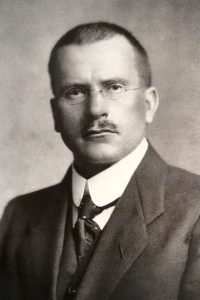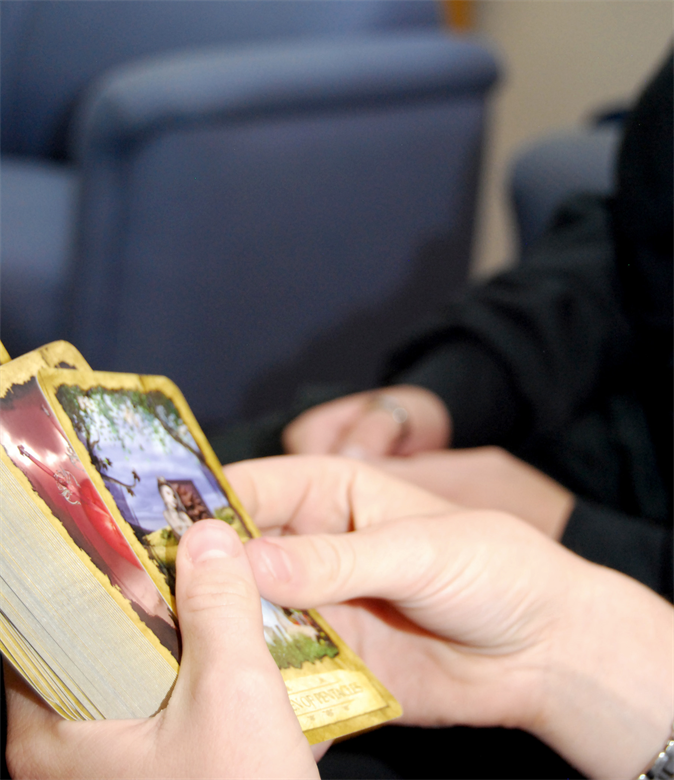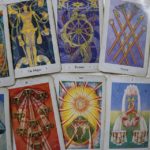When tarot cards arrived on the scene in the mid-15th century, they were not considered esoteric by nature. That is to say that they were regarded as regular – not mystical – playing cards, with the exception that there were five suits instead of the usual four. Interestingly, historians remain uncertain of the peculiars surrounding the deck’s origin. The cards are thought by some to have come from the ancient Egyptians, and by others that they were created by gypsy shamans. Influences from various world regions manifest themselves in Tarot’s rich symbolism. While there is much disagreement about the cards’ beginnings, historians agree that the deck we know today got its foothold in Northern Italy.
Tarot’s Popularity
In Italy, Tarot was first popular with the nobles. The five-suit layout spawned card games involving the concept of “trumps,” a relatively unused concept at the time. The wealthy would often commission beautiful and extravagant decks. As Tarot games became fashionable, they spread from Italy to France. Eventually, Tarot trickled down to lower castes where common people integrated (much less ornamental) cards into their games. From Europe, use of the cards spread as time went on. Tarot games eventually faded in popularity, and over time the cards adopted a new niche: as an esoteric divination tool. Full of rich and stimulating imagery, the cards lent themselves well to a mystical interpretation. Scholars and seers began studying the imagery on the cards more extensively than ever before, causing the cards’ symbolic identity to deepen and grow. Their symbolism became so entwined with mysticism, that the current understanding of Tarot Cards usually fails to separate their symbolism from their mysticism.
Supernatural Images
Though steeped in a shroud of mysticism, the imagery found on Tarot cards is not innately supernatural. The cards utilize archetypes. Archetypes are symbols that pertain to extremely common human characters (such as the salesman or the executioner) and human experiences (such as motherhood or death.) Archetypes are utilized in many fields, such as literature, drawing, and psychology. In this way, the study of Tarot symbolism can have great secular value for fields that utilize any form of symbolism.
Non-secularly, the cards are typically used for revelation.
Some people “throw” the cards then interpret them as predictions about the future of whomever they held in their mind at the time of the throwing. Some people throw the cards after holding a question in their head, and read the cards as an answer. The use of cards depends on personal preference and philosophy.
However, most revelation of this sort is viewed by atheists as insignificant and superstitious. Atheists do not believe that the cards are divinely inspired, by nature of atheistic philosophy. So how can one use Tarot symbolism, without superstition or reverence of mysticism? The answer to that question is, funnily enough, as a divination tool! However, the concept behind such divination is founded in quite a different area than the mystical realms. It is, in fact, founded in psychology and sociology.
 Perhaps most relevant is Carl Jung. Jung studied under Freud, and one of his best-known philosophies is that, when exposed to specific images, each human individual will respond in a universal way. It was Jung’s belief that evolution instilled constant responses to such imagery, by allowing useful fears and feelings to be transferred from generation to generation.
Perhaps most relevant is Carl Jung. Jung studied under Freud, and one of his best-known philosophies is that, when exposed to specific images, each human individual will respond in a universal way. It was Jung’s belief that evolution instilled constant responses to such imagery, by allowing useful fears and feelings to be transferred from generation to generation.
In his philosophy, Jung attempted to classify these images, calling them “archetypes.”Humans have few experiences that are not strongly influenced by the culture they exist in. To discover the most valuable archetypes, Jung attempted to discern which experiences were universal. He did this through personal discernment, symbology, mythology, and the study of any art form that reflected the human psyche. Though probably impossible to accurately and completely catalog the entirety of such human experiences, Jung made the attempt. Examples include birth and marriage (romantic union.) A British Lord shares common ground with a poor, Japanese farmer in both of these regards, no matter how disparate their backgrounds.
Jungian archetype – The Shadow
One example of a Jungian archetype is “The Shadow.” Darkness, for all humans, is a primal factor in life. It brings to mind the unknown, the hidden, and the taboo. By its nature, darkness hides things from us. Unable to determine factors in our environment, one feels uncomfortable. This discomfort causes us to associate negative feelings with darkness. Conversely, when all is revealed, and one is able to determine an appropriate response to his environmental factors, one experiences the positive feelings of comfort and certainty. Breaking things down farther, Jung asked himself why these responses existed. Why is it that humans didn’t feel comforted by the veil of night, and terrified of the possibility of sunburn, for instance?
Jung found his answers in evolutionary theory.
As the human race has evolved, the people who have survived to reproduce are those with enough caution and sense to avoid dangerous situations. A human who did not fear snakes, for instance, would be much more prone to a fatal bite, and thus unable to pass on his genes to future generations. Ergo, over the course of human evolution, genes have been passed on from people who survived because of caution (and, conversely, appropriate appreciation of healthy things.)
Because humans can see and protect themselves in the daylight because the sun provides the heat we need to stay alive, and even because sunlight produces vitamin D – all of these things positive because of their biological significance – make us associate the abstract symbol of light with “good.” Because humans vision is handicapped by darkness, and because considering the unknown as dangerous is constructive for survival, darkness is associated with Hell or “evil.”More examples include why the sound of a running brook is soothing (living near water was the only way to survive,) and why foxes are commonly sly predators in children’s stories (people became wary of animals that were constantly stealing their chicken’s eggs, or preying on the small animals that, for archetypal reasons themselves, became associated with innocence and vulnerability.) Our ancestors have passed to us the personality traits that allowed their survival, and certain reactions to some of life’s constants (it’s archetypes) are very uniform.
Keeping Jung’s ideas in mind
Keeping Jung’s ideas in mind, one may begin to see how tarot symbolism can be used. Rather than an esoteric divination tool, tarot can be tool used in reflection and meditation. After the process of “throwing” tarot cards, the next step is to interpret them. The symbols in the tarot deck, as studied by historians, seem to be strongly related to Jung’s archetypes. Thus, one way to approach the cards is with the belief that tarot symbols stir some of the most primal parts of our subconscious minds, bringing forward primal responses. Noting and dissecting these responses, flavored by your own life experience and unique identity, allows for very worthwhile introspection.
This process is similar to the horoscope phenomena; almost anyone can resonate with and make connections about the predictions horoscopes contain. Written with general statements that can apply to a variety of situations, people call to mind specific events in their personal lives that fit the given criteria. An example might be a horoscope stating:” money will be on your mind, and you need to be careful around new friends.” The fact that money problems are a constant in modern existence and that “being careful,” “friends,” and “new”are open to personal definition, allow various application. One person might read it and conclude that they should reconsider a business move he had been thinking about, perhaps because of a new business partner who cannot be fully trusted. Another might conclude that she shouldn’t spend so much money at a local coffee shop haunt, and that “being careful” around a “new friend” is prudent because of the possibility of a flowering relationship.
Because money is relevant to all of us, and caution around new acquaintances is natural (people are rarely comfortable with complete freedom in uncharted territory,) people from extremely different sectors can relate to the same prediction. These concepts are universal. Though such archetypal experiences are universally related to, the specifics projected onto the horoscope skeleton reflect an individual’s psyche in a personal way. For some, this prompted sort of introspection is extremely useful. People not naturally inclined to introspection can especially benefit from the outside direction.
Therefore, atheists who are looking for a meditation or reflection tool can find great value in tarot cards, without the tinge of superstition or mystical energy. And since archetypes are used in various fields, learning about symbolism, in general, can enrich one’s personal understanding and appreciation of literature, art, history, and a myriad of other things.






